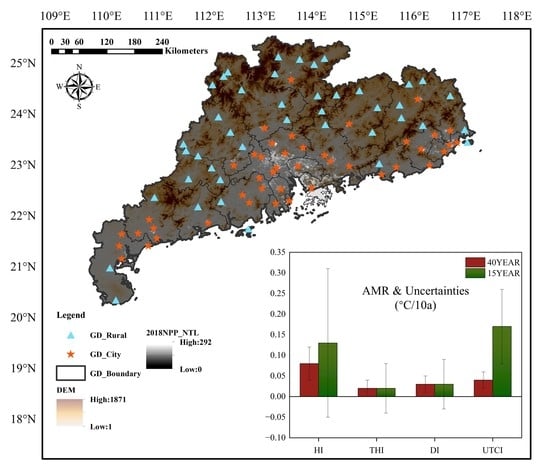Comparisons of the Urbanization Effect on Heat Stress Changes in Guangdong during Different Periods
Abstract
1. Introduction
2. Materials and Methods
2.1. Data Sources
2.2. Methods
2.2.1. Computations of Thermal Comfort Indices
2.2.2. Separation of Urban and Rural Site Divisions and Urbanization Impacts
2.2.3. Drivers Analysis Methods
3. Results
3.1. Characteristics of Long-Term Changes of Various Thermal Comfort Indices
3.2. Contribution of Urbanization to Thermal Comfort Indices and Its Variations through Time
4. Discussions
4.1. Variation of Different Thermal Comfort Indices with Temperature and Humidity
4.2. Driving Factors Analysis of Regional Thermal Comfort Indices
5. Conclusions
- (1)
- All four thermal comfort indices show an overall warming trend between 1979 and 2018. The direct thermal comfort indices (e.g., HI, THI, and DI) show warming trends at the 5% significance level (0.25 ± 0.18 °C/10a, 0.07 ± 0.06 °C/10a, and 0.09 ± 0.07 °C/10a, respectively), while the physiological thermal comfort index (UTCI) does not warm significantly (0.08 ± 0.12 °C/10a, 0.08 ± 0.10 °C/10a). This indicates that using different thermal comfort indices helps to understand the temporal and spatial changes in regional heat stress in southern China from different perspectives.
- (2)
- In terms of spatial distribution, the thermal comfort indices show more pronounced warming trends in urban areas than those in rural areas, which shows that the heat stress in the study area is affected by urbanization to a certain extent. From 1979–2018, the urbanization effect on all four thermal comfort indices reaches significance at the 5% level (0.08 ± 0.04 °C/10a, 0.02 ± 0.01 °C/10a, 0.03 ± 0.01 °C/10a, 0.04 ± 0.02 °C/10a, 0.04 ± 0.02 °C/10a); during the period of 2004–2018 when regional vegetation greening occurs, the urbanization effect on the direct thermal comfort indices becomes insignificant (0.13 ± 0.18 °C/10a, 0.02 ± 0.06 °C/10a, and 0.03 ± 0.06 °C/10a, respectively), while it remains significant (0.17 ± 0.09 °C/10a) for UTCI. From the perspective of human thermal health problems caused by urbanization, we agree with Fan et al. [43] that the UTCI in the Guangdong–Hong Kong–Macau Greater Bay Area has certain advantages over the above direct thermal comfort indices.
- (3)
- Analysis of the driving factors of thermal comfort indices may aptly explain the difference in the urbanization effects of specific indices. The direct thermal comfort indices (HI, THI, and DI) in the study area are primarily determined by the air temperature. Due to the greening of vegetation over the past few years, the warming due to urbanization has become insignificant [55], and thus the urbanization effects on the direct thermal comfort indices are similarly insignificant. However, wind speed plays a more critical role in the physiological index (UTCI): Decreasing wind speeds in urban areas leads to an increase in UTCI, while wind speeds in rural areas increase instead, thus widening the UTCI differences between urban and rural.
Supplementary Materials
Author Contributions
Funding
Data Availability Statement
Acknowledgments
Conflicts of Interest
References
- Wang, J.; Chen, Y.; Liao, W.; He, G.; Tett, S.; Yan, Z.; Zhai, P.; Feng, J.; Ma, W.; Huang, C.; et al. Anthropogenic Emissions and Urbanization Increase Risk of Compound Hot Extremes in Cities. Nat. Clim. Chang. 2021, 11, 1084–1089. [Google Scholar] [CrossRef]
- Mora, C.; Dousset, B.; Caldwell, I.; Powell, F.; Geronimo, R.; Bielecki, C.; Counsell, C.; Dietrich, B.; Johnston, E.; Louis, L.; et al. Global Risk of Deadly Heat. Nat. Clim. Chang. 2017, 7, 501–506. [Google Scholar] [CrossRef]
- Wang, Y.; Wang, A.; Zhai, J.; Tao, H.; Jiang, T.; Su, B.; Yang, J.; Wang, G.; Liu, Q.; Gao, C.; et al. Tens of Thousands Additional Deaths Annually in Cities of China between 1.5 °C and 2.0 °C Warming. Nat. Commun. 2019, 10, 3376. [Google Scholar] [CrossRef] [PubMed]
- Guo, Y.; Gasparrini, A.; Li, S.; Sera, F.; Vicedo-Cabrera, A.; Coelho, M.; Saldiva, P.; Lavigne, E.; Tawatsupa, B.; Punnasiri, K.; et al. Quantifying Excess Deaths Related to Heatwaves under Climate Change Scenarios: A Multicountry Time Series Modelling Study. PLoS Med. 2018, 15, e1002629. [Google Scholar] [CrossRef]
- Baldwin, J.; Dessy, J.; Vecchi, G.; Oppenheimer, M. Temporally Compound Heat Wave Events and Global Warming: An Emerging Hazard. Earths Future 2019, 7, 411–427. [Google Scholar] [CrossRef]
- Matthews, T.; Wilby, R.; Murphy, C. Communicating the Deadly Consequences of Global Warming for Human Heat Stress. Proc. Natl. Acad. Sci. USA 2017, 114, 3861–3866. [Google Scholar] [CrossRef]
- Kephart, J.L.; Sánchez, B.N.; Moore, J.; Schinasi, L.H.; Bakhtsiyarava, M.; Ju, Y.; Gouveia, N.; Caiaffa, W.T.; Dronova, I.; Arunachalam, S.; et al. City-Level Impact of Extreme Temperatures and Mortality in Latin America. Nat. Med. 2022, 28, 1700–1705. [Google Scholar] [CrossRef]
- Chen, L.; Ng, E. Outdoor Thermal Comfort and Outdoor Activities: A Review of Research in the Past Decade. Cities 2012, 29, 118–125. [Google Scholar] [CrossRef]
- Yan, Y.; Yue, S.; Liu, X.; Wang, D.; Chen, H. Advances on Assessment of Bioclimatic Comfort Conditions at Home and Abroad. Adv. Earth Sci. 2013, 28, 1119–1125. [Google Scholar] [CrossRef]
- Coccolo, S.; Kampf, J.; Scartezzini, J.-L.; Pearlmutter, D. Outdoor Human Comfort and Thermal Stress: A Comprehensive Review on Models and Standards. Urban Clim. 2016, 18, 33–57. [Google Scholar] [CrossRef]
- Potchter, O.; Cohen, P.; Lin, T.-P.; Matzarakis, A. Outdoor Human Thermal Perception in Various Climates: A Comprehensive Review of Approaches, Methods and Quantification. Sci. Total Environ. 2018, 631–632, 390–406. [Google Scholar] [CrossRef]
- Steadman, R.G. A Universal Scale of Apparent Temperature. J. Appl. Meteorol. Climatol. 1984, 23, 1674–1687. [Google Scholar] [CrossRef]
- Rothfusz, L.P.; NWSSR Headquarters. The Heat Index Equation (or, More than You Ever Wanted to Know about Heat Index); National Oceanic and Atmospheric Administration, National Weather Service, Office of Meteorology: Fort Worth, TX, USA, 1990; Volume 9023, p. 640. [Google Scholar]
- Blazejczyk, K.; Epstein, Y.; Jendritzky, G.; Staiger, H.; Tinz, B. Comparison of UTCI to Selected Thermal Indices. Int. J. Biometeorol. 2012, 56, 515–535. [Google Scholar] [CrossRef]
- Schlatter, T.W. Temperature-Humidity Index. In Climatology; Springer: Boston, MA, USA, 1987; pp. 837–838. ISBN 978-0-387-30749-7. [Google Scholar]
- Thom, E.C. The Discomfort Index. Weatherwise 1959, 12, 57–61. [Google Scholar] [CrossRef]
- Gulyás, A.; Unger, J.; Matzarakis, A. Assessment of the Microclimatic and Human Comfort Conditions in a Complex Urban Environment: Modelling and Measurements. Build. Environ. 2006, 41, 1713–1722. [Google Scholar] [CrossRef]
- Ji, Y.; Song, J.; Shen, P. A Review of Studies and Modelling of Solar Radiation on Human Thermal Comfort in Outdoor Environment. Build. Environ. 2022, 214, 108891. [Google Scholar] [CrossRef]
- Yang, W.; Wong, N.H.; Jusuf, S. Thermal Comfort in Outdoor Urban Spaces in Singapore. Build. Environ. 2013, 59, 426–435. [Google Scholar] [CrossRef]
- Brode, P.; Fiala, D.; Błażejczyk, K.; Holmér, I.; Jendritzky, G.; Kampmann, B.; Tinz, B.; Havenith, G. Deriving the Operational Procedure for the Universal Thermal Climate Index (UTCI). Int. J. Biometeorol. 2012, 56, 481–494. [Google Scholar] [CrossRef]
- Fong, C.; Aghamohammadi, N.; Ramakreshnan, L.; Sulaiman, N.; Mohammadi, P. Holistic Recommendations for Future Outdoor Thermal Comfort Assessment in Tropical Southeast Asia: A Critical Appraisal. Sustain. Cities Soc. 2019, 46, 101428. [Google Scholar] [CrossRef]
- Luo, M.; Lau, N. Characteristics of Summer Heat Stress in China during 1979-2014: Climatology and Long-Term Trends. Clim. Dyn. 2019, 53, 5375–5388. [Google Scholar] [CrossRef]
- Di Napoli, C.; Allen, T.; Méndez-Lázaro, P.A.; Pappenberger, F. Heat Stress in the Caribbean: Climatology, Drivers, and Trends of Human Biometeorology Indices. Int. J. Climatol. 2023, 43, 405–425. [Google Scholar] [CrossRef] [PubMed]
- Lin, L.; Ge, E.; Liu, X.; Liao, W.; Luo, M. Urbanization Effects on Heat Waves in Fujian Province, Southeast China. Atmospheric Res. 2018, 210, 123–132. [Google Scholar] [CrossRef]
- Luo, M.; Lau, N. Increasing Heat Stress in Urban Areas of Eastern China: Acceleration by Urbanization. Geophys. Res. Lett. 2018, 45, 13060–13069. [Google Scholar] [CrossRef]
- Luo, M.; Lau, N. Increasing Human-Perceived Heat Stress Risks Exacerbated by Urbanization in China: A Comparative Study Based on Multiple Metrics. Earth’s Future 2021, 9, e2020EF001848. [Google Scholar] [CrossRef]
- Wang, Y.; Chen, L.; Song, Z.; Huang, Z.; Ge, E.; Lin, L.; Luo, M. Human-Perceived Temperature Changes over South China: Long-Term Trends and Urbanization Effects. Atmos. Res. 2019, 215, 116–127. [Google Scholar] [CrossRef]
- Wang, P.; Luo, M.; Liao, W.; Xu, Y.; Wu, S.; Tong, X.; Tian, H.; Xu, F.; Han, Y. Urbanization Contribution to Human Perceived Temperature Changes in Major Urban Agglomerations of China. Urban Clim. 2021, 38, 100910. [Google Scholar] [CrossRef]
- Oleson, K.; Monaghan, A.; Wilhelmi, O.; Barlage, M.; Brunsell, N.; Feddema, J.; Hu, L.; Steinhoff, D. Interactions between Urbanization, Heat Stress, and Climate Change. Clim. Chang. 2015, 129, 525–541. [Google Scholar] [CrossRef]
- Epstein, Y.; Moran, D.S. Thermal Comfort and the Heat Stress Indices. Ind. Health 2006, 44, 388–398. [Google Scholar] [CrossRef]
- Chakraborty, T.; Venter, Z.S.; Qian, Y.; Lee, X. Lower Urban Humidity Moderates Outdoor Heat Stress. AGU Adv. 2022, 3, e2022AV000729. [Google Scholar] [CrossRef]
- Wu, F.; Yang, X.; Shen, Z. Regional and Seasonal Variations of Outdoor Thermal Comfort in China from 1966 to 2016. Sci. Total Environ. 2019, 665, 1003–1016. [Google Scholar] [CrossRef]
- Qaid, A.; Bin Lamit, H.; Ossen, D.R.; Raja Shahminan, R.N. Urban Heat Island and Thermal Comfort Conditions at Micro-Climate Scale in a Tropical Planned City. Energy Build. 2016, 133, 577–595. [Google Scholar] [CrossRef]
- Wang, C.; Zhan, W.; Liu, Z.; Li, J.; Li, L.; Fu, P.; Huang, F.; Lai, J.; Chen, J.; Hong, F.; et al. Satellite-Based Mapping of the Universal Thermal Climate Index over the Yangtze River Delta Urban Agglomeration. J. Clean. Prod. 2020, 277, 123830. [Google Scholar] [CrossRef]
- Wang, Z.; Xiao, Z.; Tam, C.-Y.; Pan, W.; Chen, J.; Hu, C.; Ren, C.; Wei, W.; Yang, S. The Projected Effects of Urbanization and Climate Change on Summer Thermal Environment in Guangdong-Hong Kong-Macao Greater Bay Area of China. Urban Clim. 2021, 37, 100866. [Google Scholar] [CrossRef]
- Harris, I.; Osborn, T.J.; Jones, P.; Lister, D. Version 4 of the CRU TS Monthly High-Resolution Gridded Multivariate Climate Dataset. Sci. Data 2020, 7, 109. [Google Scholar] [CrossRef]
- Wan, Z.; Hook, S.; Hulley, G. MYD11A2 MODIS/Aqua Land Surface Temperature/Emissivity 8-Day L3 Global 1km SIN Grid V006. In NASA EOSDIS Land Process; LP DAAC: Sioux Falls, SD, USA, 2015. [Google Scholar] [CrossRef]
- Didan, K. MYD13A3 MODIS/Aqua Vegetation Indices Monthly L3 Global 1km SIN Grid V006. In NASA EOSDIS Land Process; LP DAAC: Sioux Falls, SD, USA, 2015. [Google Scholar] [CrossRef]
- Chen, B.; Shi, G. Estimation of the Distribution of Global Anthropogenic Heat Flux. Atmos. Ocean. Sci. Lett. 2012, 5, 108–112. [Google Scholar] [CrossRef]
- Chen, B.; Dong, L.; Shi, G.; Li, L.; Chen, L. Anthropogenic Heat Release: Estimation of Global Distribution and Possible Climate Effect. J. Meteorol. Soc. Jpn. 2014, 92A, 157–165. [Google Scholar] [CrossRef]
- Xu, X. Chinese Population Spatial Distribution Kilometer Grid Dataset. Data Registration and Publication System of Resource and Environment Data Cloud Platform. p. 2017. Available online: http://www.resdc.cn/DOI (accessed on 20 March 2022).
- Jarvis, A.; Reuter, H.I.; Nelson, A.; Guevara, E. Hole-Filled SRTM for the Globe Version 4. 2008, Volume 15, p. 5. Available online: http://srtm.csi.cgiar.org (accessed on 20 March 2022).
- Fan, P.; Chun, K.; Mijic, A.; Mah, D.; He, Q.; Choi, B.; Lam, C.; Yetemen, O. Spatially-Heterogeneous Impacts of Surface Characteristics on Urban Thermal Environment, a Case of the Guangdong-Hong Kong-Macau Greater Bay Area. Urban Clim. 2022, 41, 101034. [Google Scholar] [CrossRef]
- Fiala, D.; Havenith, G.; Brode, P.; Kampmann, B.; Jendritzky, G. UTCI-Fiala Multi-Node Model of Human Heat Transfer and Temperature Regulation. Int. J. Biometeorol. 2012, 56, 429–441. [Google Scholar] [CrossRef]
- Havenith, G.; Fiala, D.; Blazejczyk, K.; Richards, M.; Bröde, P.; Holmer, I.; Rintamaki, H.; Benshabat, Y.; Jendritzky, G. The UTCI-Clothing Model. Int. J. Biometeorol. 2012, 56, 461–470. [Google Scholar] [CrossRef]
- Matzarakis, A.; Rutz, F.; Mayer, H. Modelling Radiation Fluxes in Simple and Complex Environments: Basics of the RayMan Model. Int. J. Biometeorol. 2010, 54, 131–139. [Google Scholar] [CrossRef] [PubMed]
- Blazejczyk, K. Assessment of Recreational Potential of Bioclimate Based on the Human Heat Balance. In Proceedings of the First International Workshop on Climate, Tourism and Recreation. Report of a Workshop, Halkidiki, Greece, 5–10 October 2001; pp. 133–152. [Google Scholar]
- Di Napoli, C.; Barnard, C.; Prudhomme, C.; Cloke, H.; Pappenberger, F. ERA5-HEAT: A Global Gridded Historical Dataset of Human Thermal Comfort Indices from Climate Reanalysis. Geosci. Data J. 2021, 8, 2–10. [Google Scholar] [CrossRef]
- Chao, L.; Huang, B.; Yuanjian, Y.; Jones, P.; Cheng, J.; Yang, Y.; Li, Q. A New Evaluation of the Role of Urbanization to Warming at Various Spatial Scales: Evidence from the Guangdong-Hong Kong-Macau Region, China. Geophys. Res. Lett. 2020, 47, e2020GL089152. [Google Scholar] [CrossRef]
- Li, Q.; Zhang, H.; Liu, X.; Huang, J. Urban Heat Island Effect on Annual Mean Temperature during the Last 50 Years in China. Theor. Appl. Climatol. 2004, 79, 165–174. [Google Scholar] [CrossRef]
- Li, Q. Statistical Modeling Experiment of Land Precipitation Variations since the Start of the 20th Century with External Forcing Factors. Chin. Sci. Bull. 2020, 65, 2266–2278. [Google Scholar] [CrossRef]
- Qian, G.; Li, Q.; Li, C.; Li, H.; Wang, X.L.; Dong, W.; Jones, P. A Novel Statistical Decomposition of the Historical Change in Global Mean Surface Temperature. Environ. Res. Lett. 2021, 16, 054057. [Google Scholar] [CrossRef]
- Yang, Y.; Wu, B.; Shi, C.; Zhang, J.; Li, Y.; Tang, W.; Wen, H.; Zhang, H.; Shi, T. Impacts of Urbanization and Station-Relocation on Surface Air Temperature Series in Anhui Province, China. Pure Appl. Geophys. 2013, 170, 1969–1983. [Google Scholar] [CrossRef]
- Yang, Y.; Zhang, M.; Li, Q.; Chen, B.; Gao, Z.; Ning, G.; Liu, C.; Li, Y.; Luo, M. Modulations of Surface Thermal Environment and Agricultural Activity on Intraseasonal Variations of Summer Diurnal Temperature Range in the Yangtze River Delta of China. Sci. Total Environ. 2020, 736, 139445. [Google Scholar] [CrossRef]
- Chao, L.; Li, Q.; Dong, W.; Yang, Y.; Guo, Z.; Huang, B.; Zhou, L.; Jiang, Z.; Zhai, P.; Jones, P. Vegetation Greening Offsets Urbanization-Induced Fast Warming in Guangdong, Hong Kong, and Macao Region (GHMR). Geophys. Res. Lett. 2021, 48, e2021GL095217. [Google Scholar] [CrossRef]
- Guo, H.; Xu, M.; Hu, Q. Changes in Near-Surface Wind Speed in China: 1969–2005. Int. J. Climatol. 2011, 31, 349–358. [Google Scholar] [CrossRef]
- Li, Z.; Song, L.; Ma, H.; Xiao, J.; Wang, K.; Chen, L. Observed Surface Wind Speed Declining Induced by Urbanization in East China. Clim. Dyn. 2018, 50, 735–749. [Google Scholar] [CrossRef]
- Castiglia Feitosa, R.; Wilkinson, S.J.; Oliveira, B.; Hacon, S. Wind and Greenery Effects in Attenuating Heat Stress: A Case Study. J. Clean. Prod. 2021, 291, 125919. [Google Scholar] [CrossRef]
- Li, Y.; Li, Z.; Wu, H.; Zhou, C.; Liu, X.; Leng, P.; Yang, P.; Wu, W.; Tang, R.; Shang, G.; et al. Biophysical Impacts of Earth Greening Can Substantially Mitigate Regional Land Surface Temperature Warming. Nat. Commun. 2023, 14, 121. [Google Scholar] [CrossRef]
- Ng, E.; Chen, L.; Wang, Y.; Yuan, C. A Study on the Cooling Effects of Greening in a High-Density City: An Experience from Hong Kong. Build. Environ. 2012, 47, 256–271. [Google Scholar] [CrossRef]
- Lai, D.; Liu, W.; Gan, T.; Liu, K.; Chen, Q. A Review of Mitigating Strategies to Improve the Thermal Environment and Thermal Comfort in Urban Outdoor Spaces. Sci. Total Environ. 2019, 661, 337–353. [Google Scholar] [CrossRef]
- Sajad, Z.; Naser, H.; Elahi, S.H.; Rasoul, H.; Keyvan, S.; Saeid, A. Comparing Universal Thermal Climate Index (UTCI) with Selected Thermal Indices/Environmental Parameters during 12 Months of the Year. Weather Clim. Extrem. 2018, 19, 49–57. [Google Scholar] [CrossRef]
- Ng, E.; Yuan, C.; Chen, L.; Ren, C.; Fung, J.C.H. Improving the Wind Environment in High-Density Cities by Understanding Urban Morphology and Surface Roughness: A Study in Hong Kong. Landsc. Urban Plan. 2011, 101, 59–74. [Google Scholar] [CrossRef]
- Ng, E. Policies and Technical Guidelines for Urban Planning of High-Density Cities—Air Ventilation Assessment (AVA) of Hong Kong. Build. Environ. 2009, 44, 1478–1488. [Google Scholar] [CrossRef]
- He, Y.; Liu, Z.; Ng, E. Parametrization of Irregularity of Urban Morphologies for Designing Better Pedestrian Wind Environment in High-Density Cities—A Wind Tunnel Study. Build. Environ. 2022, 226, 109692. [Google Scholar] [CrossRef]
- He, B.; Ding, L.; Prasad, D. Wind-Sensitive Urban Planning and Design: Precinct Ventilation Performance and Its Potential for Local Warming Mitigation in an Open Midrise Gridiron Precinct. J. Build. Eng. 2020, 29, 101145. [Google Scholar] [CrossRef]
- He, B. Potentials of Meteorological Characteristics and Synoptic Conditions to Mitigate Urban Heat Island Effects. Urban Clim. 2018, 24, 26–33. [Google Scholar] [CrossRef]
- He, B.; Ding, L.; Prasad, D. Outdoor Thermal Environment of an Open Space under Sea Breeze: A Mobile Experience in a Coastal City of Sydney, Australia. Urban Clim. 2020, 31, 100567. [Google Scholar] [CrossRef]
- He, B.; Ding, L.; Prasad, D. Relationships among Local-Scale Urban Morphology, Urban Ventilation, Urban Heat Island and Outdoor Thermal Comfort under Sea Breeze Influence. Sustain. Cities Soc. 2020, 60, 102289. [Google Scholar] [CrossRef]
- Yong, Z.; Li, K.; Xiong, J.; Cheng, W.; Wang, Z.; Sun, H.; Ye, C. Integrating DMSP-OLS and NPP-VIIRS Nighttime Light Data to Evaluate Poverty in Southwestern China. Remote Sens. 2022, 14, 600. [Google Scholar] [CrossRef]
- Błażejczyk, K. BioKlima-Universal Tool for Bioclimatic and Thermophysiological Studies. Available online: https://www.igipz.pan.pl/bioklima-crd.html (accessed on 8 August 2022).
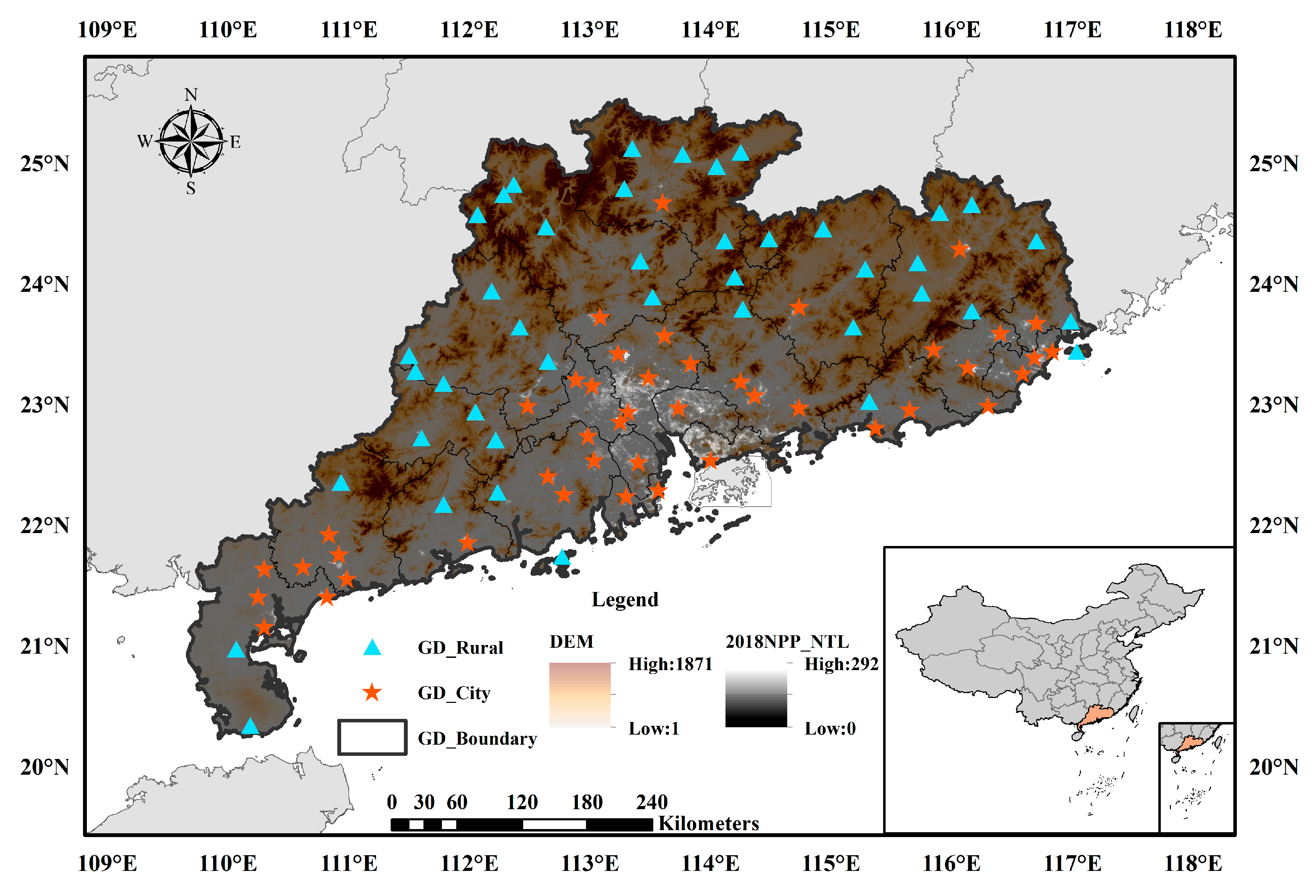



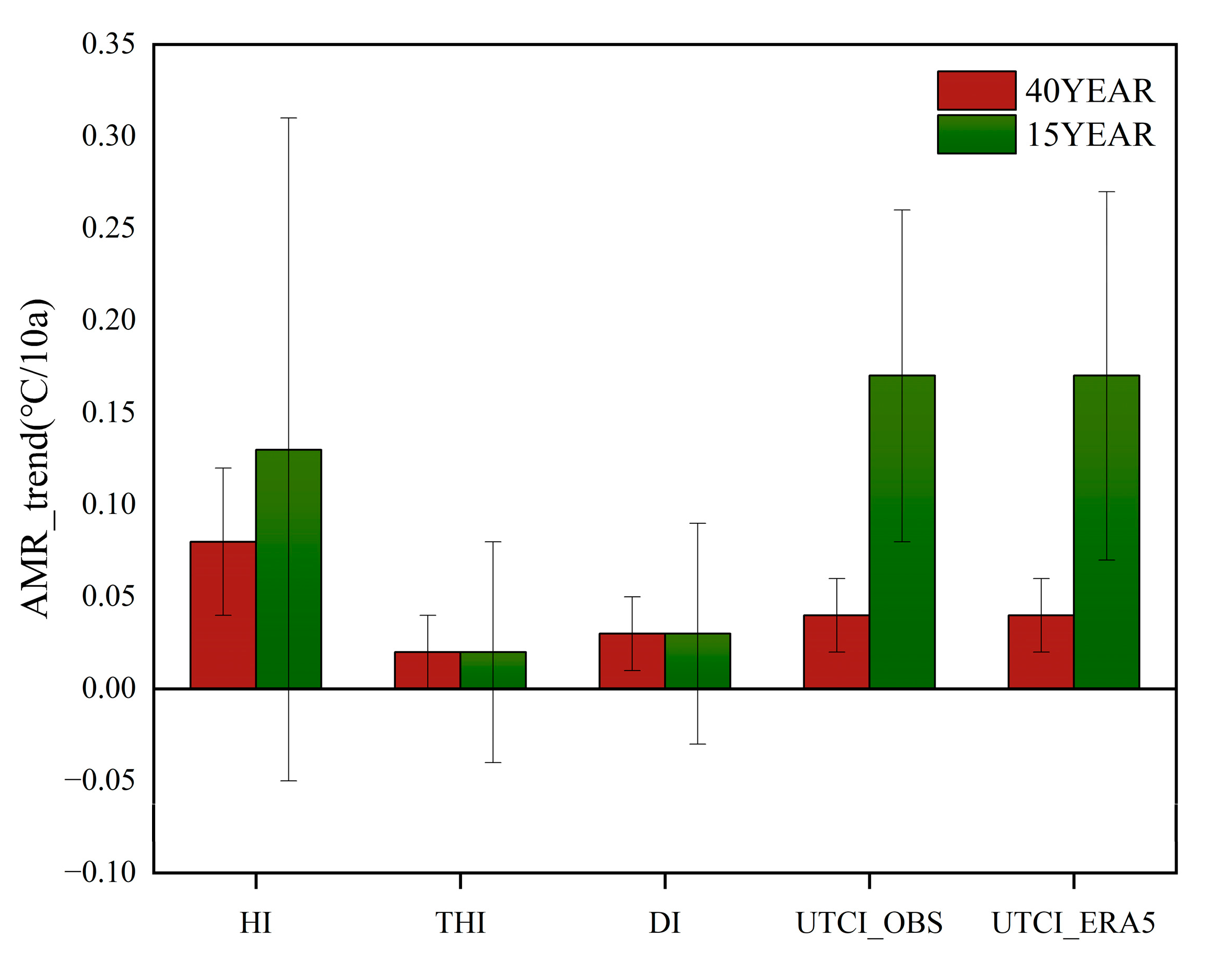
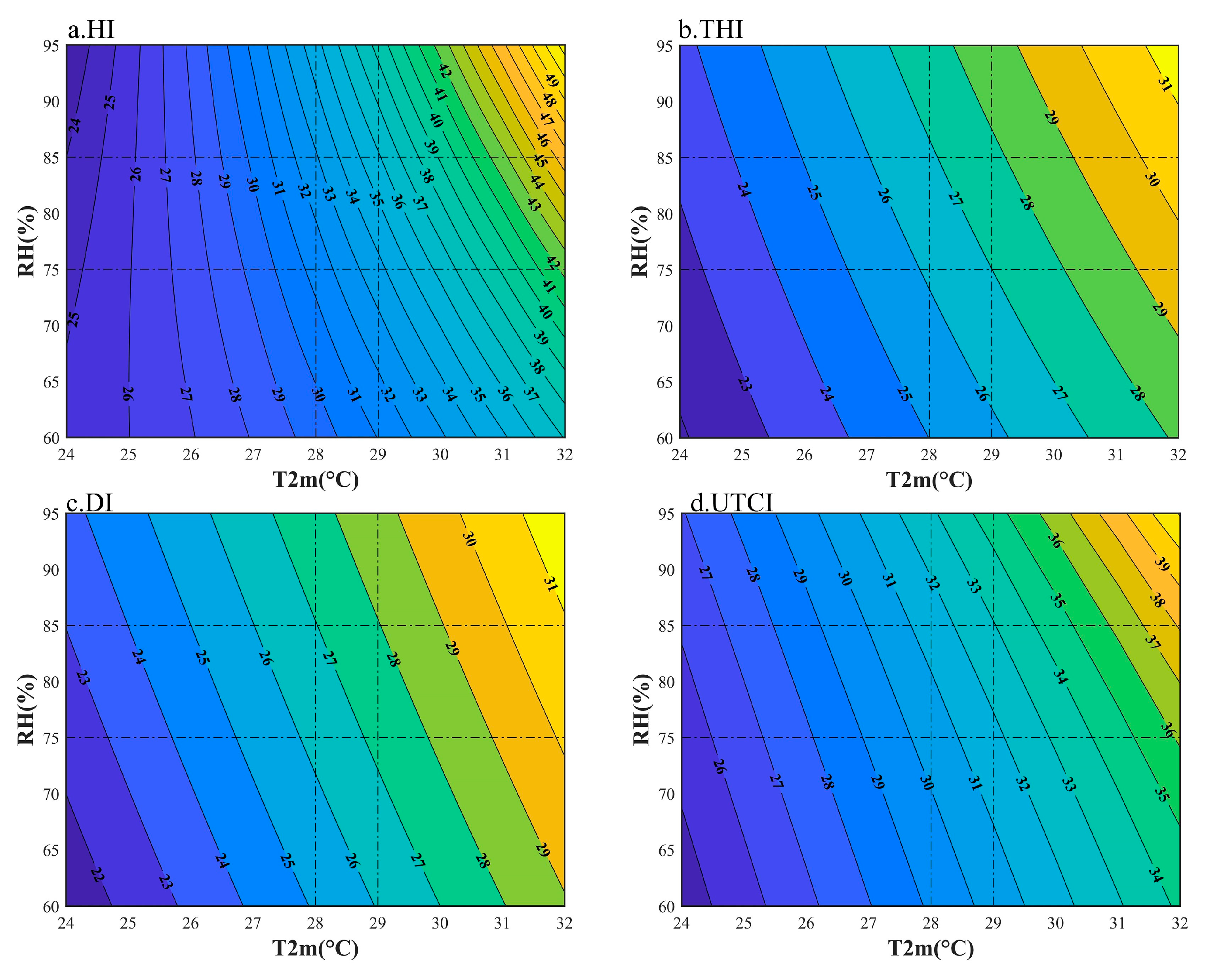
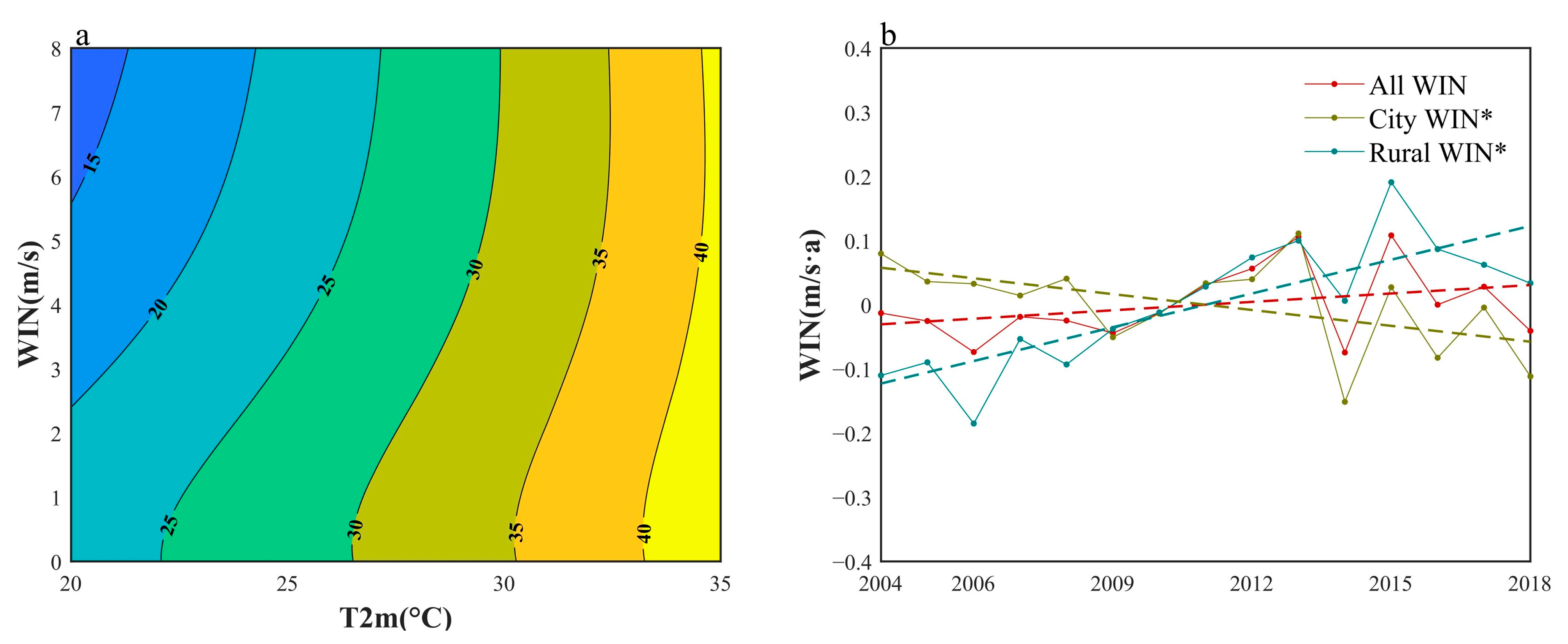
| Thermal Comfort Indices | Formula | References |
|---|---|---|
| Heat Index (HI) | [14] | |
| Temperature-Humidity Index (THI) | [15] | |
| Discomfort Index (DI) | , and: | [16,29] |
| Universal Thermal Climate Index (UTCI) |
UTCI = T + Offset(T, Tmrt, v, P)
| [20] |
| Time | Variable | ALL | City | Rural | AMR |
|---|---|---|---|---|---|
| 1979–2018 | T2m | 0.13 ± 0.08 | 0.17 ± 0.08 | 0.09 ± 0.08 | 0.04 ± 0.02 |
| HI | 0.25 ± 0.18 | 0.33 ± 0.20 | 0.17 ± 0.17 | 0.08 ± 0.04 | |
| THI | 0.07 ± 0.06 | 0.10 ± 0.06 | 0.05 ± 0.06 | 0.02 ± 0.01 | |
| DI | 0.09 ± 0.07 | 0.11 ± 0.07 | 0.06 ± 0.07 | 0.03 ± 0.01 | |
| UTCI_OBS | 0.08 ± 0.12 | 0.12 ± 0.13 | 0.04 ± 0.11 | 0.04 ± 0.02 | |
| UTCI_ERA5 | 0.08 ± 0.10 | 0.12 ± 0.11 | 0.04 ± 0.09 | 0.04 ± 0.02 | |
| 2004–2018 | T2m | 0.09 ± 0.35 | 0.12 ± 0.40 | 0.05 ± 0.32 | 0.04 ± 0.08 |
| HI | 0.75 ± 0.85 | 0.87 ± 0.97 | 0.62 ± 0.76 | 0.13 ± 0.18 | |
| THI | 0.30 ± 0.31 | 0.32 ± 0.33 | 0.28 ± 0.29 | 0.02 ± 0.06 | |
| DI | 0.29 ± 0.32 | 0.32 ± 0.35 | 0.27 ± 0.30 | 0.03 ± 0.06 | |
| UTCI_OBS | 0.46 ± 0.56 | 0.62 ± 0.62 | 0.29 ± 0.50 | 0.17 ± 0.09 | |
| UTCI_ERA5 | 0.44 ± 0.50 | 0.61 ± 0.56 | 0.27 ± 0.46 | 0.17 ± 0.10 |
| Station Classification | Thermal Comfort Indices | R2 | Drive Factor Ranking |
|---|---|---|---|
| All | HI | 0.82 | DEM * LSTn * RH PRE SSD LSTd AHF WIN EVI |
| THI | 0.83 | DEM * LSTn * PRE LSTd SSD AHF WIN RH EVI | |
| DI | 0.83 | DEM * LSTn * RH PRE SSD LSTd WIN AHF EVI | |
| UTCI_OBS | 0.75 | WIN * DEM * LSTn * RH PRE SSD EVI LSTd AHF | |
| UTCI_ERA5 | 0.72 | WIN * DEM * LSTn * PRE EVI RH ANF SSD LSTd | |
| City | HI | 0.49 | LSTn * DEM * LSTd RH EVI WIN SSD PRE AHF |
| THI | 0.52 | DEM * LSTn * RH LSTd PRE AHF SSD WIN EVI | |
| DI | 0.50 | DEM * LSTn * LSTd PRE SSD AHF EVI RH WIN | |
| UTCI_OBS | 0.70 | WIN * DEM * LSTn * RH SSD EVI LSTd AHF PRE | |
| UTCI_ERA5 | 0.69 | WIN * DEM * LSTn * SSD EVI PRE AHF RH LSTd | |
| Rural | HI | 0.78 | DEM * LSTn * RH PRE AHF SSD LSTd WIN EVI |
| THI | 0.80 | DEM * LSTn * PRE WIN RH AHF LSTd SSD EVI | |
| DI | 0.79 | DEM * LSTn * PRE RH WIN AHF SSD LSTd EVI | |
| UTCI_OBS | 0.73 | WIN * DEM * LSTn * PRE AHF RH EVI SSD LSTd | |
| UTCI_ERA5 | 0.67 | WIN * DEM * LSTn * PRE EVI SSD AHF LSTd RH |
Disclaimer/Publisher’s Note: The statements, opinions and data contained in all publications are solely those of the individual author(s) and contributor(s) and not of MDPI and/or the editor(s). MDPI and/or the editor(s) disclaim responsibility for any injury to people or property resulting from any ideas, methods, instructions or products referred to in the content. |
© 2023 by the authors. Licensee MDPI, Basel, Switzerland. This article is an open access article distributed under the terms and conditions of the Creative Commons Attribution (CC BY) license (https://creativecommons.org/licenses/by/4.0/).
Share and Cite
Li, W.; Chao, L.; Si, P.; Zhang, H.; Li, Q. Comparisons of the Urbanization Effect on Heat Stress Changes in Guangdong during Different Periods. Remote Sens. 2023, 15, 2750. https://doi.org/10.3390/rs15112750
Li W, Chao L, Si P, Zhang H, Li Q. Comparisons of the Urbanization Effect on Heat Stress Changes in Guangdong during Different Periods. Remote Sensing. 2023; 15(11):2750. https://doi.org/10.3390/rs15112750
Chicago/Turabian StyleLi, Wen, Liya Chao, Peng Si, Huixian Zhang, and Qingxiang Li. 2023. "Comparisons of the Urbanization Effect on Heat Stress Changes in Guangdong during Different Periods" Remote Sensing 15, no. 11: 2750. https://doi.org/10.3390/rs15112750
APA StyleLi, W., Chao, L., Si, P., Zhang, H., & Li, Q. (2023). Comparisons of the Urbanization Effect on Heat Stress Changes in Guangdong during Different Periods. Remote Sensing, 15(11), 2750. https://doi.org/10.3390/rs15112750







